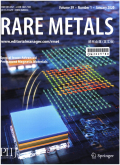- 钛学术文献服务平台 \
- 学术期刊 \
- 工业技术期刊 \
- 冶金工业期刊 \
- 稀有金属(英文版)期刊 \
Nonsolvent-induced phase separation-derived TiO2 nanotube arrays/porous Ti electrode as high-energy-density anode for lithium-ion batteries
Nonsolvent-induced phase separation-derived TiO2 nanotube arrays/porous Ti electrode as high-energy-density anode for lithium-ion batteries
基本信息来源于合作网站,原文需代理用户跳转至来源网站获取
摘要:
TiO2 nanotube arrays,growing on three-dimensional (3D) porous Ti membrane,were synthesized using a facile nonsolvent-induced phase separation and anodization process.The length of those three-dimensional nanotube arrays could be tuned by prolonging the anodizing time.When the anodizing time is 8 h,the three-dimensional TiO2 nanotube arrays/porous Ti electrode exhibits well cycling stability and ultra-high specific capacity,which is used in lithium-ion batteries,attributed to the high utilization rate of the substrate and the high growth intensity of the active materials.Three-dimensional TiO2 nanotube arrays/porous Ti electrode,at 100 μA·cm-2 with 8 h anodizing time,shows a typical discharge plateau at 1.78 V and exhibits the specific capacity with 2126.7 μAh·cm-2.The novel nanotube arrays@3D porous architecture effectively shortens the electron/ion transmission path,which could pave way for optimizing the design of high-performance anode materials for next-generation energy storage system.

推荐文章
Cu-Ti合金与H2O2直接氧化法制备Cu掺杂TiO2薄膜
TiO2
半导体薄膜
光催化
化学合成
氢化TiO2 包覆核壳C/Fe3O4@rGO 锂离子电池阳极材料
锂离子电池
Fe3O4
氢化TiO2
碳材料
包覆
N掺杂TiO2/Ti液膜光催化处理染料废水
溶胶-凝胶法
N-TiO2/Ti膜电极
双极液膜反应器
光催化
TiO2形貌调控研究
形貌
TiO2
合成
内容分析
关键词云
关键词热度
相关文献总数
(/次)
(/年)
引文网络
引文网络
二级参考文献 (217)
共引文献 (7)
参考文献 (25)
节点文献
引证文献 (0)
同被引文献 (0)
二级引证文献 (0)
1957(1)
- 参考文献(0)
- 二级参考文献(1)
1967(1)
- 参考文献(0)
- 二级参考文献(1)
1981(1)
- 参考文献(0)
- 二级参考文献(1)
1988(1)
- 参考文献(0)
- 二级参考文献(1)
1993(1)
- 参考文献(0)
- 二级参考文献(1)
1995(1)
- 参考文献(0)
- 二级参考文献(1)
1996(1)
- 参考文献(0)
- 二级参考文献(1)
1997(1)
- 参考文献(0)
- 二级参考文献(1)
1998(1)
- 参考文献(0)
- 二级参考文献(1)
1999(1)
- 参考文献(0)
- 二级参考文献(1)
2000(1)
- 参考文献(0)
- 二级参考文献(1)
2001(1)
- 参考文献(0)
- 二级参考文献(1)
2002(4)
- 参考文献(0)
- 二级参考文献(4)
2003(1)
- 参考文献(0)
- 二级参考文献(1)
2005(6)
- 参考文献(0)
- 二级参考文献(6)
2006(5)
- 参考文献(0)
- 二级参考文献(5)
2007(6)
- 参考文献(0)
- 二级参考文献(6)
2008(12)
- 参考文献(0)
- 二级参考文献(12)
2009(4)
- 参考文献(0)
- 二级参考文献(4)
2010(15)
- 参考文献(0)
- 二级参考文献(15)
2011(19)
- 参考文献(0)
- 二级参考文献(19)
2012(17)
- 参考文献(0)
- 二级参考文献(17)
2013(20)
- 参考文献(0)
- 二级参考文献(20)
2014(24)
- 参考文献(1)
- 二级参考文献(23)
2015(23)
- 参考文献(0)
- 二级参考文献(23)
2016(20)
- 参考文献(1)
- 二级参考文献(19)
2017(16)
- 参考文献(2)
- 二级参考文献(14)
2018(19)
- 参考文献(4)
- 二级参考文献(15)
2019(17)
- 参考文献(15)
- 二级参考文献(2)
2020(2)
- 参考文献(2)
- 二级参考文献(0)
2021(0)
- 参考文献(0)
- 二级参考文献(0)
- 引证文献(0)
- 二级引证文献(0)
引文网络交叉学科
相关学者/机构
期刊影响力
稀有金属(英文版)
主办单位:
中国有色金属学会
出版周期:
月刊
ISSN:
1001-0521
CN:
11-2112/TF
开本:
16开
出版地:
北京学院路2号
邮发代号:
创刊时间:
1989
语种:
eng
出版文献量(篇)
2804
总下载数(次)
0
总被引数(次)
9706
期刊文献
相关文献
推荐文献
- 期刊分类
- 期刊(年)
- 期刊(期)
- 期刊推荐
一般工业技术
交通运输
军事科技
冶金工业
动力工程
化学工业
原子能技术
大学学报
建筑科学
无线电电子学与电信技术
机械与仪表工业
水利工程
环境科学与安全科学
电工技术
石油与天然气工业
矿业工程
自动化技术与计算机技术
航空航天
轻工业与手工业
金属学与金属工艺
稀有金属(英文版)2022
稀有金属(英文版)2021
稀有金属(英文版)2020
稀有金属(英文版)2019
稀有金属(英文版)2018
稀有金属(英文版)2017
稀有金属(英文版)2016
稀有金属(英文版)2015
稀有金属(英文版)2014
稀有金属(英文版)2013
稀有金属(英文版)2012
稀有金属(英文版)2011
稀有金属(英文版)2010
稀有金属(英文版)2009
稀有金属(英文版)2008
稀有金属(英文版)2007
稀有金属(英文版)2006
稀有金属(英文版)2005
稀有金属(英文版)2004
稀有金属(英文版)2003
稀有金属(英文版)2002
稀有金属(英文版)2001
稀有金属(英文版)2000
稀有金属(英文版)1999
稀有金属(英文版)2021年第8期
稀有金属(英文版)2021年第7期
稀有金属(英文版)2021年第6期
稀有金属(英文版)2021年第5期
稀有金属(英文版)2021年第4期
稀有金属(英文版)2021年第3期
稀有金属(英文版)2021年第2期
稀有金属(英文版)2021年第12期
稀有金属(英文版)2021年第1期

 免费查重
免费查重










